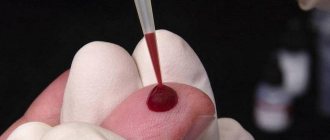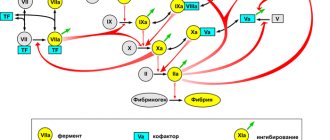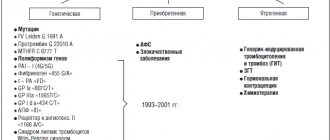The hemostatic system is complex, multicomponent and performs a lot of functions, the most important of which are stopping bleeding, maintaining blood in a liquid state, and participating in the healing of damage to organs and tissues.
It includes blood coagulation factors, biological molecules, platelets, vascular walls, as well as neurohumoral mechanisms that regulate the functioning of these factors. A disruption of the hemostasis system can occur when one or more components fail. As a result, the balance between coagulation and anticoagulation mechanisms is disrupted, with the development of certain consequences for the body.
Causes of hemostasis system disorders
There are acquired and congenital. Acquired conditions include:
- interference in the antigenic structure of platelets due to viral agents, certain medications, autoimmune processes;
- damage to the red bone marrow by ionizing radiation, tumor processes, chemicals;
- impaired vascular wall permeability due to decreased collagen synthesis;
- liver diseases, which lead to a decrease in the production of various blood clotting factors;
- lack of vitamin K.
Congenital causes of disorders of the hemostatic system include thrombocytopenia, von Willebrand disease, changes in genes that encode the synthesis of blood coagulation factors, and hereditary hypofibrinemia.
Clinical manifestations
Symptoms of disorders of the hemostatic system largely depend on which component is affected. If the predominance is on the side of coagulation factors, then a pronounced clinical picture is often absent. Typically, patients are concerned about general malaise (headache, weakness, fatigue), which is not always a reason for them to seek medical help. Characteristic symptoms of disorders of the hemostatic system appear with vascular thrombosis. In such cases, heart attack, stroke, pulmonary embolism, and disseminated intravascular coagulation syndrome may develop. These conditions result in severe consequences for the body and often cause death.
When there are disturbances in the hemostatic system that lead to the activation of anticoagulant components, the following symptoms develop:
- increased bleeding of gums;
- pinpoint hemorrhages on the skin (petechiae);
- the appearance of bruises for no apparent reason;
- If the integrity of the skin is damaged, the blood does not stop for a long time.
Bleeding can be not only external, but also internal. It is not always possible to recognize them in advance, which can also lead to serious consequences for the body.
Hemostasis test for pregnant women
The threat of large blood loss during childbirth is the main criterion that guides the obstetrician-gynecologist when prescribing a hemostasis test for a pregnant woman. However, in addition to this, a hemostasiogram can be prescribed by the doctor monitoring the course of pregnancy in the case when the patient develops gestosis or has uterine hypertonicity, there is a threat of miscarriage, or there is a delay in intrauterine development of the child. A hemostasis test is usually prescribed even if the pregnancy is multiple. When observed by an obstetrician-gynecologist in a medical clinic, a woman undergoes all necessary examinations during pregnancy.
Methods for diagnosing disorders of the hemostatic system
The following methods can be used to identify pathology:
- determination of bleeding time (according to Duke, according to Ivey, according to Lee-White);
- general blood test with formula;
- determination of platelet aggregation;
- prothrombin time (PTT) and prothrombin index (PTI);
- activated partial thromboplastin time (aPTT), etc.
Depending on the specific disorders of the hemostatic system, the doctor may prescribe both individual indicators and a comprehensive study - a coagulogram. It includes indicators such as PTT, PTI, APTT, determination of fibrinogen and D-dimer levels, etc.
In order to confirm or refute the hereditary nature of disorders of the hemostatic system, genetic testing is prescribed. You can take it in medical genetics.
Indications for hemostasis analysis
A bleeding disorder is primarily a serious contraindication for any surgery, so a hemostasis test is required before surgery. This diagnosis is also necessary for pregnant women, since during childbirth, a blood clotting disorder can pose a threat to the woman’s life. In addition, the doctor can prescribe this diagnosis in Yeysk for the following indications:
- Moderate to severe liver diseases: the liver is a hematopoietic organ.
- Diseases of the endocrine system: the blood clotting process is affected by the level of hormones.
- Pathologies of the cardiovascular and urinary systems.
- Autoimmune diseases.
A doctor may prescribe this type of laboratory diagnostics in cases where the patient has frequent nosebleeds, bleeding gums, bruises and hematomas even from a minor mechanical impact (minor bruise, pressure). For varicose veins, this test is also prescribed, as it allows us to identify the likelihood of a blood clot.
Preparing for hemostasis analysis
The described diagnosis in Yeysk requires some preparation. Blood is given for analysis in a medical clinic on an empty stomach. In addition, it is recommended not to eat food 8-12 hours before blood sampling; during this time you can drink clean, still water. On the eve of donating blood, you should avoid physical activity, stress, alcohol and medications that affect hematopoiesis. This primarily applies to aspirin and similar drugs, which should be stopped taking at least 5 days before the hemostasis test.
Examination of temporary disability in LKK "Sensitive"
Medical certificate for entry into civil service
New rules for a medical certificate for weapons
Why enter into a voluntary health insurance agreement?
Certificates for service at LKK Sensitive
Medical certificate to carry a weapon
Voluntary health insurance agreement
Medical examination in Yeysk
Study of hemocoagulation in various patients for 50 years. Part 1
1. Bokarev I.N. Effect of treatment with glucocorticoid hormones on some blood coagulation parameters. Therapeutic archive. 1967;2.
2. Bokarev I.N. Determination of antihemophilic globulin "A" in the plasma of patients receiving steroid therapy. Soviet medicine. 1968;11.
3. Bokarev I.N. The effect of treatment with glucocorticoid hormones on some indicators of blood clotting in a number of diseases in the clinic of internal medicine. Diss... cand. honey. Sci. Moscow, 1968.
4. Bokarev I.N. Anticoagulant and thrombolytic therapy in the clinic of internal diseases. Moscow: Publishing house 1st MMI, 1972.
5. Bokarev I.N., Chumakova N.I. Hemostasis disorders and laboratory methods for their diagnosis. Moscow: Publishing house 1st MMI, 1973.
6. Ananchenko V.G., Bokarev I.N. and others. The influence of heparin therapy on the course of pneumonia in acute poisoning. Soviet medicine. 1976;9.
7. Pavlova Z.V., Bokarev I.N., Varlamova O.A., Madzhuga A.V. and others. The role of intravascular coagulation in the pathogenesis of postoperative pneumonia in patients with lung cancer. Anesthesiology and resuscitation. 1978;2:58-62.
8. Bokarev I.N. Treatment of internal diseases through targeted pharmacological regulation of hemostasis. In the book. New in research methods, diagnosis and prevention of major diseases. Coagulology. Moscow: Publishing house 1st MMI, 1975:82-84.
9. Theoretical and practical aspects of clinical coagulology. Collection of scientific papers. Moscow: Publishing house of the 1st MMI named after. THEM. Sechenov, 1975.
10. Komarov F.I., Bokarev I.N., Ershov V.I. The role of the hemostatic system in the pathogenesis of rheumatoid arthritis. Therapeutic archive. 1975; 11:24–31.
11. Smolenski VS, Bokarev IN, Ershov VI et al. Erfahrungen den Fibrinolyse Aktivatoren und Inhibitoren Anwendung in der Innere Medizin Klinik. Folia Haematol. (Leipzig). 1974;101:1.
12. Bokarev I.N., Mindlina G.I. and others. The use of fibrinolysin therapy in patients with chronic pneumonia. In the book: New drugs, new aspects of some types of drug therapy. Moscow, Medicine, 1974.
13. Komarov F.I., Bokarev I.N., Smolyanitsky A.Ya. Issues of classification and diagnosis of acute forms of functional platelet deficiency. Clinical medicine. 1975;3:84–90.
14. Bokarev I.N., Smolyanitsky A.Ya. Methods for diagnosing thrombocytopathies. Laboratory work. 1976;4.
15. Komarov F.I., Bokarev I.N., Lyusov V.A. Pharmacological effect on the platelet component of hemostasis in the treatment of patients with coronary heart disease. Cardiology. 1978;3.
16. Komarov F.I., Marquardt F., Bokarev I.N., Kleking G.P., Aleksandrova N.A. Treatment of coronary heart disease with the drug Micristin. Soviet medicine. 1979;10:66–70.
17. Lyusov.V.A., Bokarev I.N. Treatment of thrombosis and hemorrhages in the clinic of internal diseases. Moscow: Medicine, 1976.
18. Bokarev I.N., Kuznetsov V.A., Butorov V.N. and others. The use of chromogenic substrates for the diagnosis of blood coagulation and fibrinolysis disorders. Therapeutic archive. 1981;2.
19. Bokarev I.N., Butorov V.N. and others. Application of chromogenic peptide substrates in laboratory diagnostics. Laboratory work. 1981;8.
20. Kartashova V.I., Bokarev I.N. Disseminated intravascular coagulation syndrome. Soviet medicine. 1978;8.
21. Komarov F.I., Bokarev I.N. Chronic intravascular microcoagulation in patients with coronary artery disease. Soviet medicine. 1980;8.
22. Persianinov L.S., Bokarev I.N., Makatsaria A.D. and others. Syndrome of disseminated intravascular coagulation in obstetrics. GRM. 1977:Section X:5.
23. Butorov V.N., Bokarev I.N. Possibilities of the fibrin plate method for determining the activity of components of the fibrinolytic system of the blood. Laboratory work. 1978;5.
24. Bokarev I.N., Franta J., Strop J., Didisheim P. The relationship of platelet factor 4 with platelet adhesion measured in flowing whole blood. In the book. Antithrombotic therapy in clinical practice. New in theory, diagnosis, treatment (Collection of scientific papers). Moscow, Publishing house of the 1st MMI named after. I.M. Sechenov. 1986;137-138
25. Privalova E.V. Activity of the platelet component of hemostasis, the level of von Willebrand factor and fibronectin in patients with coronary heart disease. Abstract of thesis... cand. honey. Sci. Moscow, 1985.
26. Ptushkin V.V. The effect of long-term use of the drug sulfinpyrazone on the course of coronary artery disease, the platelet component of hemostasis, the levels of von Willebrand factor and fibronectin in persons who have suffered acute myocardial infarction. Abstract of thesis... cand. honey. Sci. Moscow, 1988.
27. Smirnova I.V., Bokarev I.N. Activity of the von Willebrand factor–glycoprotein IIb–IIIa complex in patients with atherothrombosis of the heart and lower extremities against the background of type 2 diabetes mellitus. Clinical medicine. 2007;12:34–39.
28. Nesova T.N. Activity of the von Willebrand factor–glycoproteins IIb–IIIa complex in patients with stable angina and acute coronary syndrome. Abstract of thesis... cand. honey. Sci. Moscow, 2002.
29. Kiseleva Z.M., Bokarev I.N. Von Willebrand's disease - modern concepts. Thrombosis, hemostasis and rheology. 2000;3:18–21.
30. Martyukhina G.D. Arterial hypertension, atherothrombosis and von Willebrand factor system. Blood clots, bleeding and vascular disease. 2012;12:72–75.
31. Avdonin P.V., Martyukhina G.D., Zhirnik A.S. Dependence of von Willebrand factor activity on the risk stage of arterial hypertension. In the book: Thrombosis, hemostasis and vascular pathology: modern approaches to diagnosis and treatment. Moscow, 2014:7.
32. Bokarev I.N. Chronic intravascular microcoagulation in the clinic of internal diseases. Abstract of dissertation... Dr. med. Sci. Moscow, 1980.
33. Bokarev I.N. Disseminated intravascular microcoagulation. Classification issues. In the book: Materials of the II All-Union Congress of Hematologists and Transfusiologists, Moscow, 1985. P. 457.
34. Bokarev I.N. DIC syndrome, modern concepts and problems. Clinical medicine. 1992;2:109–113.
35. Smolensky V.S., Bokarev I.N., Velikov V.K. and others. About chronic intravascular coagulation in patients with diabetes mellitus. Clinical Medicine. 1982;1:49–52.
36. Bokarev I.N., Velikov V.K. and others. Chronic intravascular blood coagulation in patients with diabetic microangiopathy. Clinical medicine. 1985;4:98–99.
37. Velikov V.K., Galkina A.K., Bokarev I.N. and others. The influence of insulin and sulfonylurea derivatives on chronic intravascular microcoagulation in diabetes mellitus. Soviet medicine. 1985;9:91–93.
38. Ena Ya.M. Intravascular microcoagulation in patients with hypertension (issues of pathogenesis, clinical and laboratory diagnosis and treatment). Abstract of dissertation... Dr. med. Sci. Moscow, 1990.
39. Bokarev I.N., Shchepotin B.M., Ena Ya.M. Intravascular blood coagulation. Kyiv: Health, 1989.
40. Syatkovsky V.A. The role of general and particular mechanisms in the pathogenesis of disseminated intravascular coagulation. Abstract of dissertation... Dr. med. Sci. Moscow, 1992.
41. Lopata Yu.M., Bokarev I.N. and others. Pathological intravascular microcoagulation of blood in patients with obstructive jaundice. Soviet Medicine, 1982;11:31–36.
42. Votyakova O.M. The state of the procoagulant and fibrinolytic components of hemostasis in amyloidosis. Abstract of thesis... cand. honey. Sci. Moscow, 1991.
43. Savina T.S. Determination of the intensity of intravascular microcoagulation in individuals with abnormal hemoglobins. Abstract of dissertation. Ph.D. honey. Sci. Moscow, 1992.
44. Kim Il Han. Functional state of the platelet component of hemostasis in patients with chronic nonspecific lung diseases. Abstract of dissertation. Ph.D. honey. Sci. Moscow, 1983.
45. Komarov F.I., Bokarev I.N., Kim Il Han, Tsvetkova O.A. Lung diseases and hemostasis. Clinical medicine. 1986;6:154–158.
46. Bokarev I.N., Kim Il Han, Rytikova M.I. and others. Platelet link of hemostasis in chronic nonspecific lung diseases. Soviet medicine. 1986;10:20–23.
47. Gurdus V.O. Complex pathogenetic therapy of patients with skin angiitis taking into account hemostasis indicators. Abstract of dissertation. Ph.D. honey. Sci. Moscow, 1993.
48. Cherkasov V.L., Bokarev I.N., Babakulieva T.M. State of hemostasis in hemorrhagic syndrome in patients with erysipelas. Clinical medicine. 1986;11:88–91.
49. Cherkasov V.L., Bokarev I.N., Babakulieva T.M., Smolyanitsky A.Ya. Disorders of hemostasis and fibrinolysis in hemorrhagic erysipelas. Soviet medicine. 1989;10:105–108.
50. Shelest E.A., Shuganov A.E., Patrushev L.I., Bokarev I.N. Thrombophilia and the intensity of intravascular microcoagulation in patients with chronic obstructive pulmonary disease and atherothrombosis. Rational pharmacotherapy in cardiology. 2014;10(3):293–298.
51. Doronina A.M., Lipinsky B., Bokarev I.N. Fibrinogens and their role in atherogenesis in diabetes mellitus. Clinical medicine. 2007;7:40–44.
52. Ermolaeva O.A. The protein is a precursor of a blood clot (a soluble fibrin-monomer complex) in patients with acute coronary syndrome (myocardial infarction, unstable angina). Abstract of dissertation. Ph.D. honey. Sci. Moscow, 2003.
53. Bokarev I., Ermolaeva O. Continuous intravascular coagulation of Patients with Hemophilia. Hamophilia-200 World Congress. Montreal. July 16-21.2000. n20.
54. Zelenchuk N.M. Effect of antiplatelet agents ticlid and diabeton on the course of diabetic microangiopathy. Abstract of dissertation. Ph.D. honey. Sci. Moscow. 1990.
55. Bokarev I.N. Thrombophilic conditions and their clinical aspects. Clinical medicine. 1991;8.
56. Bokarev I.N., Popova L.V. What is thrombophilia today? Clinical medicine. 2013;91(12):4–9.
57. Patrushev L., Zykova E. Bokarev I. et al. New DNA diagnostic system for detection of Factor V Leiden. Thrombosis Research. 1998;92:251–259.
58. Zykova E.S., Patrushev L.I., Bokarev I.N. et al. New allele-specific primers for detecting the Leiden mutation in exon 10 of the factor V gene in thrombophilia. Bioorganic chemistry. 1997;23(3):205–210.
59. Zykova E.S. Development of a universal DNA diagnostic system based on PCR and its use to detect the Leiden mutation in patients with venous thrombosis. Abstract of dissertation. Ph.D. biol. Sci. Moscow, 1998.
60. Kondratyeva T.B. The influence of oral anticoagulants on the intensity of intravascular coagulation and the levels of proteins C and S. Abstract of thesis. Ph.D. honey. Sci. Moscow, 1994.
61. Popova L.V. Resistance to activated protein C in patients with arterial thrombosis. Abstract of dissertation. Ph.D. honey. Sci. Moscow, 1998.
62. Shelest E.A. Intensity of intravascular microcoagulation in patients with chronic obstructive pulmonary disease, atherothrombosis and trobophilia. Abstract of dissertation. Ph.D. honey. Sci. Moscow. 2015.
63. Kozlova T.V. Hereditary defects in the hemocoagulation system as risk factors for thrombosis. Abstract of dissertation. Dr. med. Sci. Moscow, 2006.
64. Bokarev I.N., Popova L.V., Golub A.V., Kovalenko T.F., Kondratyeva T.B., Patrushev L.I. The influence of thrombophilias in combination with other risk factors on the development of thrombosis. Quality and life. 2016;4(12):408–416.
65. Bokarev IN, Melnikov A., Golub A., Popova L., Petruchin V. Thrombophilia and pregnancy. Thesis and report in 18th Danubian League against Thrombosis and Haemorrhagic Disorders. Sarajevo, 2015.
66. Melnikov A.P., Petrukhin V.A., Popova L.V., Golub A.V. Ilyich A.V., Bokarev I.N. Heparin therapy for pathologies of pregnancy and congenital thrombophilia. Thrombosis, bleeding and vascular pathology. 2016;14:63–66.










